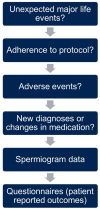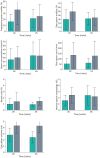Fasting for male fertility-a mixed methods study
- PMID: 39885870
- PMCID: PMC11781251
- DOI: 10.3389/fnut.2024.1529466
Fasting for male fertility-a mixed methods study
Abstract
Purpose: Approximately 10-20% of couples in Germany are unable to conceive. About 50% of this subfertility can be attributed to the male partner. Preclinical studies suggest that fasting could potentially influence central mechanisms of spermatogenesis. This study aimed at investigating feasibility and effects of a Fasting Mimicking Diet (FMD) in the context of male subfertility.
Materials and methods: In this two-arm, randomized, controlled, exploratory mixed methods study men with impaired sperm quality were randomized into a fasting and a waiting-list control group. The fasting group followed an FMD (500 kcal/d for 5 days) thrice within 4 months, while the control group was instructed to maintain their lifestyle and diet. We assessed sperm quality according to WHO criteria (total and progressive sperm motility, concentration, total sperm count, ejaculation volume and sperm morphology) from baseline to 6 months later. Semi-structured interviews were conducted in a subgroup and evaluated by structured content analysis.
Results: Recruitment proved difficult, with 18 out of only 22 recruited participants completing all visits. There were no marked group differences between fasters (n = 10, 36.9 ± 5.17 years) and controls (n = 8, 36.1 ± 2.8 years) regarding sperm parameters. Effect sizes suggest slight positive trends regarding between group changes in the ANCOVA for total sperm motility (eta2 = 0.030) progressive sperm motility (eta2 = 0.059), total sperm count (eta2 = 0.001), concentration (eta2 = 0.050), normal sperm morphology (eta2 = 0.019) and the percentage of round cells (eta2 = 0.462) in the fasting group and a general decrease of sperm quality in the control group. This decrease of sperm quality concerned all parameters but the ejaculation volume, which increased in the CG but decreased in the FG (eta2 = 0.254). The decline of sperm quality in the CG is not explicable by the study setting. We also saw positive trends concerning the intragroup changes (e.g., within group change for progressive sperm motility: d = 0.36), Qualitative analysis (10 interviews) showed FMD feasibility, and its compatibility with full-time work. Motivation toward a healthier lifestyle after the FMD and a feeling of self-empowerment concerning one's fertility were reported.
Conclusion: This limited exploratory study showed FMD feasibility but found no notable differences between groups regarding all parameters. Yet, we saw positive trends regarding the between and within group changes in favour of the fasting group. Possible beneficial effects of the FMD on sperm quality should be investigated in larger studies. Interview results suggest that fasting could be a useful supportive intervention in male subfertility regarding self-efficacy and positive lifestyle changes.
Keywords: fasting; healthy lifestyle; infertility; male; semen analysis; sperm motility.
Copyright © 2025 May, Behling, Sochiera-Plegniere, Batschari, Kessler, Michalsen, Kandil, Blakeslee, Jeitler, Stritter and Koppold.
Conflict of interest statement
AM and DK co-founded the Academy of Integrative Fasting (AIF) and board members of the Medical Association for Therapeutic Fasting and Nutrition (Ärztegesellschaft für Heilfasten und Ernährung e.V.). AM is also co-founder of the SALUFAST company and DK serves as a consultant for a mobile application on intermittent fasting (FASTIC), as well as a company producing plant-based supplements (EVERYYIN). The remaining authors declare that the research was conducted in the absence of any commercial or financial relationships that could be construed as a potential conflict of interest.
Figures





References
-
- Czeromin U, Kruessel J, Tandler-Schneider A, Verona B, Klaus F, Daniel F, et al. . Deutsches IVF-Register (D.I.R) Jahrbuch 2017. Journal fur Reproduktionsmedizin und. Endokrinologie. (2018) 15:1–55.
LinkOut - more resources
Full Text Sources

